CEO Overview – “W3C Strategy: past, present, and future”
Presenter: Jeff Jaffe
Duration: 41 min
Slides: download
Please, use the form at the end of the page to submit comments and questions.
Slides & video
Keyboard shortcuts in the video player
- Play/pause: space
- Increase volume: up arrow
- Decrease volume: down arrow
- Seek forward: right arrow
- Seek backward: left arrow
My name is Jeff Jaffe, CEO of W3C.
This year, for the first time in three years, we will have an in-person TPAC meeting.
TPAC Vancouver won't be completely in-person; we will have substantial video capability for those who will be remote.
As I am delivering these remarks three weeks prior to TPAC, I note that I tested positive after attending a W3C meeting in Berlin.
We took all imaginable precautions but we don't control COVID.
Let's hope that all that travel to Vancouver do so safely.
And I apologize if I sound a bit under the weather in this pre-record.
As we sit on the threshold of becoming a legal entity there will be many presentations given by my colleagues on that topic.
My presentation will be about one of my favorite topics, W3C Strategy, past, present, and future.
I will get to that soon but first some overview administrative information.
Please turn to slide two.
This meeting operates under our Code of Conduct, as do all of our interactions within the W3C community.
This is part of our goal of improving inclusion within W3C.
In this slide you will find a pointer to the Positive Work Environment Community Group for the evolution of this work.
Please turn to slide three.
Slide three recalls W3C's Antitrust Policy, including a reminder to all participants that they must ensure that their conduct does not violate antitrust and competition laws and regulation.
Please turn to slide four.
Shortly after the last AC meeting, prompted by an AC Forum conversation, I got to thinking about the need for crisper communication of the W3C strategy.
In my 12 years at W3C W3M has successfully executed a strategy to grow the W3C community and its impact and make progress towards our mission of leading the web to its full potential.
But we have not always communicated our results.
As we sit on the threshold of the legal entity it is timely to explain what our strategy has been, what metrics we have used, and how well we have done.
Much of this material is not new.
We have been reporting elements of our strategy over the years, but we've not packaged it consistently and expressed it as a strategy.
Now is an important time to have this conversation.
W3C is pivoting to a new structure.
First there is the new legal basis, but the new structure is broader than the legal foundation.
We are moving to a member-led paradigm.
We will have a board of directors.
With all of this change, it is vital to reflect on our strategy leading up to today and begin a conversation ultimately decided by the Board of what the strategy should become.
The word strategy is a loaded word.
An organization can have a business strategy, a marketing strategy, a technical strategy, a financial strategy.
Each of these terms cover different topics, have different objectives, and the appearance of the outcomes are different.
Which definition of strategy will I talk about?
One thing is clear: I do not plan to talk about our technical strategy.
Our technical strategy, which relates to the underlying technology of the web has been member driven, bottom up under the guidance of the TAG and the Director.
Instead, I plan to discuss W3C's organizational strategy.
That is one of the highest level objectives that W3C has as an organization, and how the W3C community has worked together to achieve those objectives.
As you pay attention to the strategy retrospective, I want you to consider the critical success factors.
In my mind, a key critical success factor has been the W3C Team led by Tim Berners-Lee and W3M.
While W3C Hosts have some formal responsibility for W3C, they have not been overly active in the last decade until recently.
The Team has benefited from the vision, example, and unique insight of our Director, Tim Berners-Lee.
As he has reduced the time he can spend working on W3C, W3M has stepped into leadership and driven enormous value for the web as we will see in the subsequent slides.
Please turn to slide five.
I just mentioned that we have always had a strategy, whether we stated it explicitly or not.
In 2011 at one of my first AC meetings I described four strategic elements: The right topics, i.e, having the best set of Working Groups, Communications, business development, and broadening outreach to stakeholders.
Over 11 years the focus has changed but many of these themes remain.
Please turn to slide six.
After introducing those four elements, I started a practice of measuring key metrics against these, which I introduced in my spring 2012 CEO presentation with a participation slide.
You know that you are talking about a strategy if you define metrics and regularly measure them.
I continued a semi-annual practice of reporting these metrics at AC meetings for 16 consecutive AC meetings until they went virtual and I felt a different format for reporting was required.
Please turn to slide seven.
Another way to truly appreciate a strategy is to see how resources are assigned.
See slide 13 for my presentation at our fall 2020 AC meeting, and we're gonna come back to this slide later when I will describe what it means in detail.
Please turn to slide eight.
The last three slides summarize how we have communicated our strategy in past meetings.
Today, I will describe the full impact of our strategy over the last decade.
In 2010 when I joined W3C our organization was in desperate need of a new strategy.
Membership was down by 50% in its previous decade.
Revenues were off.
We needed a bailout from the Internet Society to pay our bills.
Our most important spec, HTML was primarily being done at the WHATWG with some partnership with us.
We needed to make serious changes.
We convened five task forces to look at how to create a sustainable business model for W3C.
These task forces were designed to analyze what was wrong with W3C and place us on a trajectory to success.
You can see the participants on the slide.
Then, as now, we were member driven.
Over 60% of the people that participated were from the membership and the general W3C community.
I won't describe the task force conclusions in detail.
That itself is somewhat dated at this point.
But let's look at the objectives for those task forces.
We wanted to make W3C the place where people would want to bring web standards.
We wanted a sustainable business model.
We were concerned about being global, being accessible, and prioritizing users.
We were thoughtful about core technology.
From that task force came most of the strategic elements that have guided us for over a decade.
They generated the participation metrics that I referenced moments ago.
Good strategy is often described as an open loose leaf.
You have a strategy, but you respond with the times.
You add a page to the loose leaf as you add new focus areas and you drop ones that are complete or whose importance has diminished.
So while we have not completely revamped our strategy lately, in a real sense the 2010 strategy with agile modifications has been our strategy over the last decade.
Each year we re-examine the overarching goals, reset the metrics, and make the work more relevant to the times.
We add elements and sunset other elements.
I said that the purpose of the task forces was to lead us to success.
I hope as you review our strategy in the upcoming slides, you will agree that we have been successful.
Today W3C is a dynamic exciting community.
W3C's value to its members and the broader web ecosystem is immense.
Please continue to hear the journey we have been on.
Please turn to slide nine.
With that background, today's presentation reviews our key strategy elements as they have evolved over the last decade.
The key elements are nested under three strategic pillars.
The first strategic pillar is the single word participation.
For W3C to serve the web it needs to be the place where people come to work on web standards and it needs to have the right participants.
A forum for innovation and standardization only works if there is critical mass in that forum.
Under participation, first we have Global.
The web affects everyone and we need the entire planet at the table.
The second is Community.
The web architect, developer, and designer communities are huge and we need those voices at the table.
The third is Member Growth for both revenue and global reach.
The fourth is Diversity and Inclusion.
The second strategic pillar is the strength of our technical program.
A strategy goal underneath that is innovation and incubation.
We aim to be a large dynamic forum which attracts as many people as possible who can contribute to our mission.
Another key goal is addressing societal needs.
And we can only do that, all of this, with W3C Process agility.
The third strategic pillar is Member Value.
Some of it is ensuring that members are getting what they paid for.
But some of it is in serving industry needs which may be different than the core web.
The web touches everything.
So another element is partnering with other organizations.
These are critical to make W3C the most desirable place for web standards and its members the drivers of this work.
This is how W3C members contribute ideas to achieve leadership for the web at W3C.
Underneath all of this, I will describe how we assign resources because resource allocation as I said above is the essence of strategy.
Beyond these ten strategies that I will talk about, are two strategies to reach our goals for the future: the creation of a legal entity and preparing for Director-free.
These are such large topics that they are covered elsewhere in this meeting and not in my presentation.
Please turn to slide ten.
Historically, W3C was strong in Europe, US, Japan, and Korea and weak in the rest of the world.
Our global strategy is to get us strong presence everywhere.
I want to emphasize the work in China because for many years W3C was almost absent in China.
China is a huge country with a huge market.
China has a sizable web development community.
In 2010, there were no large commercial Chinese companies in W3C.
If that hadn't changed, it would have been a disaster for web architecture and interoperability.
Whenever you have two groups developing the same technology without being in contact, you run the risk of fragmentation.
And our primary technical mission is interoperability.
We quickly went to work and established a host in China.
We recruited the most important Chinese brands to join our community.
But we also realized that establishing a host is not the end of outreach to China; it is only the beginning.
We have worked so hard to ensure that we have one web community.
We have increased translations to Chinese, Japanese, and Korean.
Most importantly, we put focus on listening and bridging.
We try to understand and hear the needs of the global community.
We have an enormously active Chinese Web Interest Group.
Today we have 40+ Chinese members, including nine Full members.
A capstone achievement has been our work in MiniApps.
While we prefer that applications run in pure web environments, we recognize that they will often run in hybrid mode, leveraging web technology and marrying it with outstanding native platform capabilities.
When that became predominant in China, we began our MiniApps work to get as much interoperability as possible in the hybrid world and the pieces that use web technology.
Hundreds of millions of people using MiniApps will benefit from our standards work.
And across the globe, the web community is applying similar ideas to other hybrid app situations.
Please turn to slide 11.
Being global is not exclusively about China.
We have always been strong in Japan, which is our second largest country by membership.
Compared to the rest of the world, it is in Japan, where we have the most tight knit partnership between local members and our local team.
That allows us to better incorporate unique Japanese needs in a range of topics from publishing, telecommunications, and vertical tech support.
Our initiatives have been very successful, but we still have a great deal of work to do in the rest of the world.
Recently we have been partnering with W3C chapters in Latin America, the Persian Gulf, Australia, Southeast Asia and elsewhere to extend our footprint.
Please turn to slide 12.
If the first strategy is to increase our global reach, the second strategy is to grow the W3C community, which ensures that W3C remains the preeminent place where web standards are done.
For those who were not around ten years ago, I need to paint the bleak picture that we faced.
While we had Working Groups and the Recommendation Track, if anyone wanted to work on something new, it was nearly impossible because new ideas were often not mature enough to be on the REC Track.
When people wanted to explore something new they created a new organization for that exploration.
And if the work matured they would stay outside of W3C to finalize their standard.
That fragmentation was harmful to the web community and devastating to W3C.
We created a new track of permissionless innovation called Community Groups.
It was tough to design.
We opened it up to non-members, which was a controversial decision.
Some ask, should we as a member organization provide such value to non-members?
We decided that was a requirement if we were to build the thriving community we needed.
The success was extraordinary.
Instead of being a community of 1,500 engineers that we were in 2010, we are now a community of over 15,000 engineers, a growth of 10x.
There are so many ideas and so much energy coming out of that vastly increased participation.
Recently I was asked, what is W3C's greatest strength?
Without hesitation I answered, the W3C community.
There is simply no way to replicate what we have.
Today we have 381 Community Groups and three Business Groups.
We have broadened the community in other ways.
We provided the option of a forkable document license to appeal to the open source community.
We strengthened a pattern of doing our work in public.
And when we moved a lot of our tooling to GitHub it became easier for the public to weigh in on work in the REC Track.
A tangible result of CGs is REC Track standards.
That leads to the next related topic.
Please turn to slide 13.
Our CGs have been hugely productive.
They have 900 GitHub repositories and have exchanged more than 8,000 messages so far in 2022.
Some of the individual CG communities are huge.
The WebAssembly Community Group alone has 1,451 participants.
The Web Platform Incubator Community Group has recorded over 2,600 repository events in the last year.
The Credentials Community Group generated over 1,700 list discussions in the past 12 months.
These groups work on many topics, not only new specs.
The W3C Process Community Group is where the W3C community meets to keep our processes agile and relevant.
In the last few years, we have seen a novel workflow where a CG has a tight relationship with a Working Group.
The CG incubates the next set of ideas, then passes them off to the Working Group.
This creates a tight cycle of innovation and adoption, which helps us rapidly evolve our technologies.
The slide lists some key CGs to exemplify several of these points.
Please turn to slide 14.
W3C has been noted for its commitment to accessibility since Tim Berners-Lee's letter of September 1996.
From that early beginning we have increased investment and focus in many areas to address key society concerns.
It starts with accessibility.
We are a values-driven organization.
As the web became more critical to society, we could not allow anyone to be left out.
There are over 1 billion people with disabilities worldwide and all deserve full access to the web.
Today, over 100 W3C member organizations have expressed interest in or directly participate in the Web Accessibility Initiative activities illustrating the strength of our effort.
Our flagship Accessibility Guidelines are standard for the web, are often adopted by corporations as corporate imperatives, and are often adopted as regulatory requirements.
Most notably in the EU with their EN 301 549.
Earlier this year the longtime director of WAI, Judy Brewer, won a top level ACM award, the ACM Policy Award.
While we are proud of our success in accessibility, we have more to do.
Despite accessibility work being a core part of W3C's commitment, member interest, and success, this work has been largely externally funded, placing additional burden on the accessibility staff.
It is time that W3C moves forward on a path towards normalizing the funding of this work by allocating more membership funding to these important activities.
In internationalization we ensure that there is language enablement, developer support, and author support across many languages.
We maintain a large matrix of gaps, illustrated in this slide, to improve the support of different languages on the web.
Our Privacy Interest Group and our security reviews recognize that in the rush to get the web up and running there have been compromises on privacy and security.
We aim to restore better privacy and security in balance with the growth of functional needs.
We have long been sensitive to these horizontal review areas, but as we have matured we have become much more systematic.
Only in 2012 did we add the horizontal review requirement into our guidebook on how to create a Working Group.
We have spent years improving the tooling for horizontal reviews.
In 2021 we actually performed 891 reviews across a range of charters and specs.
Talking about reviews brings me to the TAG, the Technical Architecture Group.
For several years now under the strong leadership of Dan Appelquist and Peter Linss, the TAG has been a steady hand in guiding the technical architecture of the web.
The key methodology is architecture review of specs.
They review the work of groups and advise in how to make it compliant with the rest of the web.
In 2021 they actually closed 674 review requests, amounting to 128 completed design reviews.
While on the topic of the TAG and key to our values is the Ethical Web Principles document published in May 2022.
It's now in the W3C Statement Track recently introduced in the W3C Process.
This landmark document provides important guidance and shows our commitment to building an architecture which is values-based and addresses societal needs.
Overall, the percentage of W3C technical staff working on societal needs has grown from 21% to 33% in ten years.
Please turn to slide 15.
Over the last decade, we reversed a decline in membership and have shown consistent growth.
In the last ten years, membership has grown by over 50%.
In the previous ten years it had declined by 37%.
Aside from the baseline numbers of total members, the growth has been particularly healthy because we have had a larger number of large companies that are members, showing a greater impact on the economy at large.
As I will discuss momentarily, we are seeing greater representation across industries, showing a broadening of our appeal.
On the other hand we have a significant number of startup members always bringing in new ideas.
We achieve this growth despite various recessions in the economy and despite merger activity in some industries.
And we achieve the growth despite the reduction in independent browser engines.
So underneath the top line growth, we see vitality in the organization at many levels.
Please turn to slide 16.
At the outset the web facilitated access to global data and allowed everyone to be a publisher.
Soon companies use this capability to use the web for corporate advertising and marketing.
The technologies needed to support this were quite common: HTML, CSS, DOM, and other core specs of the web.
But more recently various industries have leveraged the web as an infrastructure for their core business.
For businesses as diverse as retail sales, telecommunications, publishing and media, there are unique needs for web technology to support those businesses.
While W3C provided only modest support for that in the early years, that has become a key focus in recent years.
See the bar chart on the slide, which describes when we introduced various industry areas together with some other new focus areas.
In 2014 we took it to the next level.
We created a Champion program.
For each industry, a Team Contact was asked to work with thought leaders in those industries.
The objective was to develop a common vision with two components.
We wanted to learn how we could improve the capabilities of the industry with additional web standards.
And we want to learn how those standards at times could enhance the Web overall, being a better technology base for all users and consumers.
This has had a huge impact.
There are over 60 REC Track specs that are either being developed or have been developed that are industry specific.
In 2015 I reported to the AC that 55% of our Full members are industry specific.
As a part of our total, 32% of all members being industry specific.
Some of the impact is visible in our recognition.
In the last seven years W3C has won three Emmy Awards, showing the impact of our work on television.
We've had impact on other industries as well, although not every industry has such a visible means of recognition.
Please turn to slide 17.
The web technology stack touches the technologies of many organizations.
To maximize our leverage requires that we broadly partner with everyone.
We don't have the bandwidth to deeply partner with all other groups.
So we have simple liaisons with many partners and select a few to have deep partnerships with.
We have approximately 100 liaisons overall.
I still remember my first AC meeting in 2010 just as I was starting.
Members wanted a relationship with ISO to upstream our standards to that community at that time.
The request had been dormant for a long time.
I went to the microphone to ask whether there were any objections to upstreaming to ISO.
None were offered.
So we established a status of being a Submitter of our Publicly Available Specs to the ISO standards.
Our deepest partnership is with the WHATWG.
There was an unfortunate schism 15 years ago which caused a team of spec writers to develop HTML outside of W3C.
When they formalized the organization in 2017, I provided a same-day blog post congratulating them for their progress and hoping we would work together.
It was hard to swallow W3C's primacy for HTML, but we always prioritize first for the web and only second for W3C.
As a result, we have since developed two MOUs to work with the WHATWG on HTML, DOM, Fetch, and other specs.
Our broadest partnership is with the IETF since they provide standards that underlie the web.
We work with them on security, privacy, IoT and many other areas.
And together we are creating WebRTC standards.
Sometimes the partnerships result in a merger, as when we brought IDPF folks into W3C in 2016.
To succeed in industry verticals we work with EMVCo on payments, COVESA for automotive, CTA for media and entertainment, as well as others such as OGC for geospatial.
Please turn to slide 18.
At the end of the day, W3C's product is our specifications.
So it is essential that part of our strategic focus relates to continuous improvement in how we generate standards.
Since 2014 we have a new mechanism whereby we enhance our Process almost every year.
We removed Last Call from the Process steps, we added a living standards track, we've included CEPC by reference, we added Registries.
The table on this slide illustrates some of the key innovations in process agility over the last decade.
Process agility is not limited to the formal Process steps on the Recommendation Track.
It also relates to our tooling.
In the early years of W3C there was no great tooling for what we do.
So we invented our own.
Today there are industry tools such as GitHub.
So we customize industry tools for our own needs.
In the W3C GitHub instance in 2021 there were nearly 10,000 contributions per month on average, where a contribution is either an issue, a comment, or a pull request.
There are other features on how we make spec development more agile, and we have eased the requirements on spec publishing so that more groups can publish.
ClearSpec 2021 provides more clarity about the provenance of our specs.
Please turn to slide 19.
Next, I want to talk about Member value.
You might find that to be strange; after all, every strategic element that I've been discussing is aimed to add Member value.
But here I mean something specific.
I'm talking about the way that we have held the line on price increases for Member dues.
That is to say we are providing more and more and it is costing less.
To be fair, this adds pressure on the Team to deliver more, but we have made that decision recognizing that Members have limited funds to pay for membership.
Please look at the table on this slide.
Our last general price increase was in 2008.
Think about it; 14 years ago.
You can see in the second column what the fees were at that time.
In 2015 we had a modest 12% increase but only for the largest firms.
In the interim we slashed prices for mid-size companies and startups.
In the fourth column you see that aside from the largest companies either there was no price increase or a marked decrease.
We held the line despite inflation.
The fifth column shows the real value of our current dues after 14 years of inflation using the US Consumer Price Index as the benchmark.
And the final column shows that in real terms everyone's dues have become substantially lower.
So all of the gain and function we provide is accompanied by a reduction in real cost.
How do we do that?
By cleverly relocating resources to where they are needed as we will demonstrate in a couple of slides.
Please turn to slide 20.
We have barely scratched the surface of the topics of diversity and inclusion but we have made some steady progress.
Let's start with the requirement.
The W3C technical community that sets technical standards for the web should look like our stakeholders and broadly draw inspiration from all of our stakeholders.
Since the web serves the planet that means that our community must look like the planet, but it doesn't.
The requirement to look like all of our stakeholders might be too far to reach for a member organization, but it's still helpful to keep that imperative in front of ourselves just to realize how far we most improve.
Over the past several years we have tried to address diversity and inclusion in several ways.
We are insisting on a positive work environment.
A decade ago, our emails were loaded with snark, defined as snide, sarcastic, or disrespective of others.
In 2015 we became one of the first standards organizations to create a Code of Conduct, but we didn't rest there.
When we saw a more comprehensive code in the Geek Feminism site, we adapted that to improve our Code in 2021.
That's not to say that we are perfect; we have more to do, but the Code has been a useful anchor to improve the situation.
In 2018 we started to provide diversity scholarships for people from underrepresented communities to participate at W3C's annual conference, TPAC.
We provide an annual report on progress and diversity in the senior W3C bodies.
In the past several years, we have made measurable progress.
Of all of our goals, this is one for which we have the most work in front of ourselves to get to where we want to be.
How can we together make even more of a difference?
That's something we need to keep working on.
Please turn to slide 21.
We have discussed our success in 10 strategy elements.
How have we been so successful making so much progress across so many strategic elements?
It is the power of the community.
The W3C Team is a very small team.
The W3C community is a very large community.
The Team works to leverage the strength of the broader community by playing a key facilitation role.
But resource allocation within the Team to provide the right facilitation is critical.
If we assign people on the Team to work on a topic it is more likely that we bring the parties together to get the right solution.
Let's get back to the table I briefly showed on slide seven.
Two years ago at TPAC 2020 I shared the graphic from this slide during my AC presentation.
It demonstrated how W3C had reassigned Team technical resources over a decade.
Initially there was enormous investment working on the technology of the core web.
Tim worked closely with the Team to make sure that we got the technology right.
But as Tim reduced his personal efforts, as the community and the TAG strengthened their own ability in technical architecture, the need for Team resources lay elsewhere.
Team resources were required to support the aforementioned strategy areas.
So we shifted Team technical resources to focus on issues of incubation, building a larger community, to industry needs, facilitating areas where stakeholders themselves have fewer technical resources.
The societal needs of accessibility, privacy, and security, and to various efforts to make us more global, both specific work on internationalization as well supporting technical needs from around the globe such as the MiniApps work.
To be sure, the fact that we have broadly shifted resources to new areas of strategy is not complete.
At any point in time one never has perfection in terms of assigning resources.
For example, from my point of view, while we have greatly improved the assignment of resources to societal needs, underneath that we still require more investments in security and privacy.
Those topics have bedeviled the web for some time, and there is much more work to do to improve the situation.
Please turn to slide 22.
Today I provided a retrospective on our strategy.
It is fair to say that we have succeeded in working together to add value to this community called W3C.
We have made some progress on all of these elements and in some of them such as overall participation, membership, industry focus, and outreach to China, we have made incredible progress.
Each strategic initiative involved choices.
Did we make the right choices?
Should we have emphasized different areas?
Would different choices have made us even more successful?
We'll never know looking backwards, but the reason to assemble where we have been is to look forward.
So the key question is what should our strategy be going forward?
Are the topics we have pursued in the past decade the right ones for the future?
How will we deal with newer issues such as sustainability, misinformation, and how will we have outreach to a wider set of web stakeholders?
In my April 2022 recorded presentation I discussed the top 10 reasons that we need a legal entity.
Among the reasons were that a legal entity has a broadly based board of directors of leading lights to help guide the organization.
Ultimately that new board of directors will provide its imprint on the organization.
I look forward to working with the Board and the W3C community on that topic.
Please turn to slide 23.
Thank you for your attention today.
I hope that my illness did not make my presentation too difficult with my coughing.
I apologize for that.
I am looking forward to your participation in person or remotely at TPAC.
Thank you and have a good day.


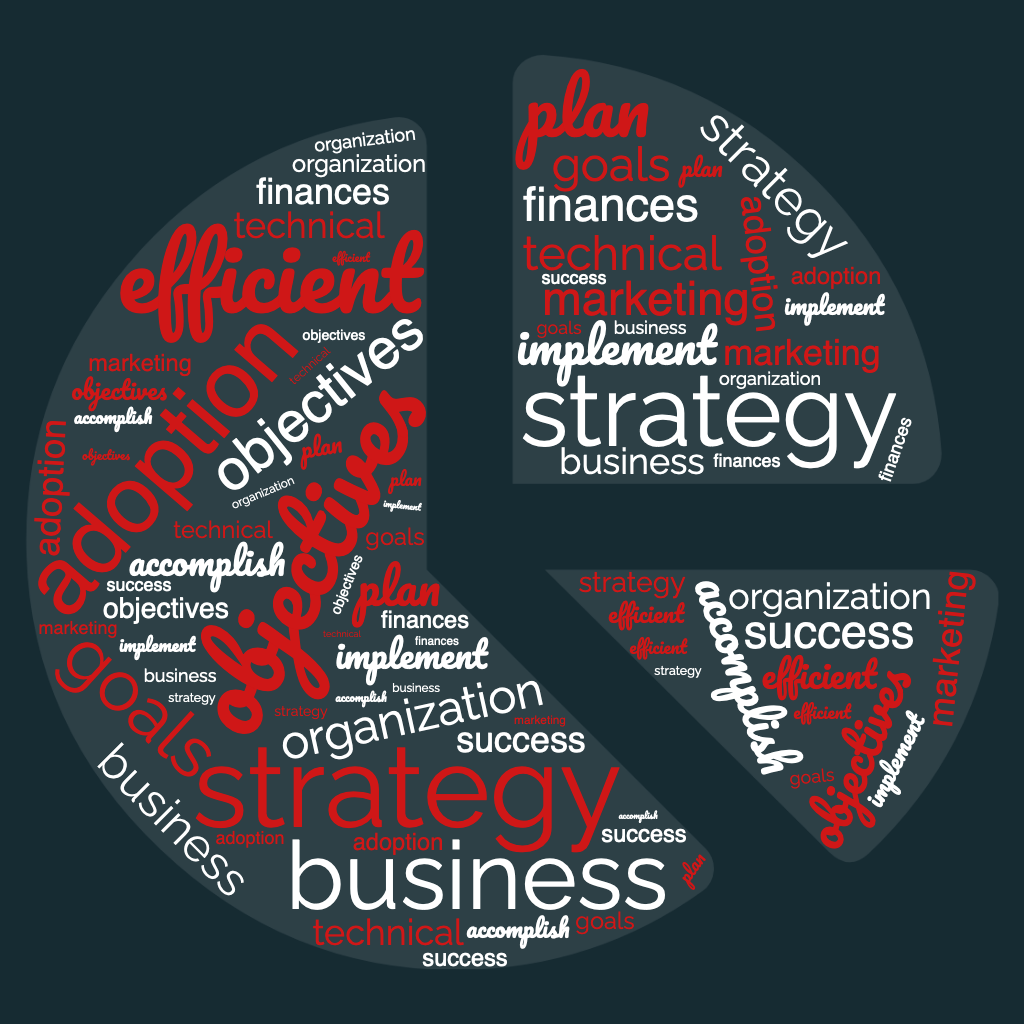
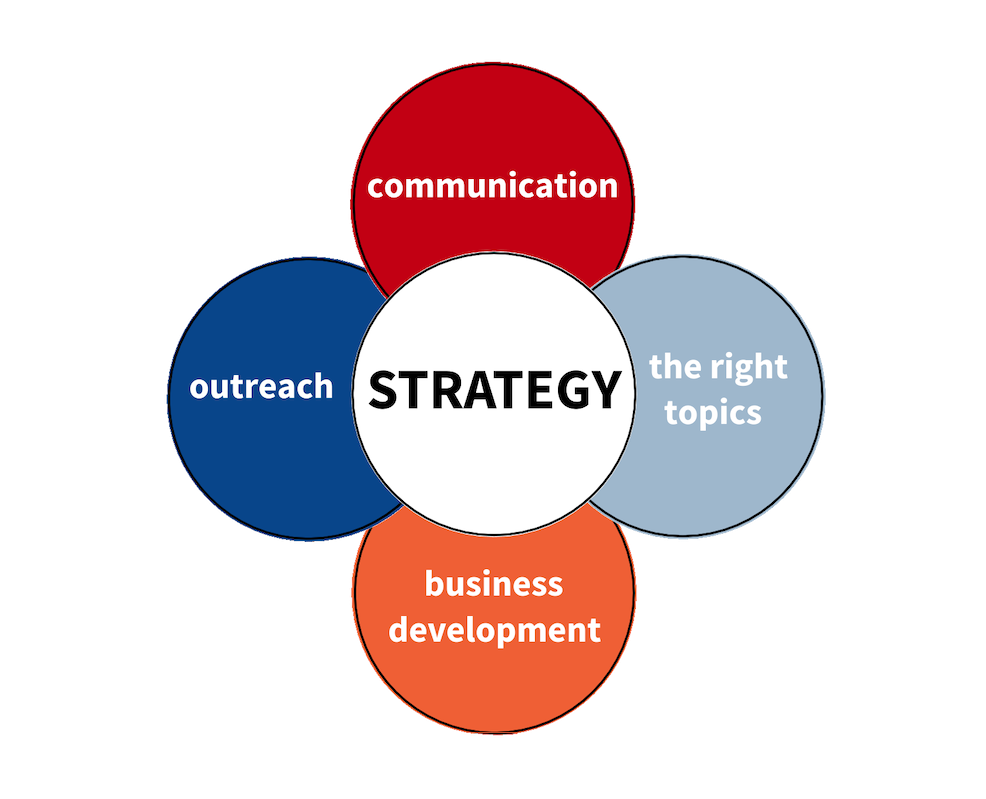
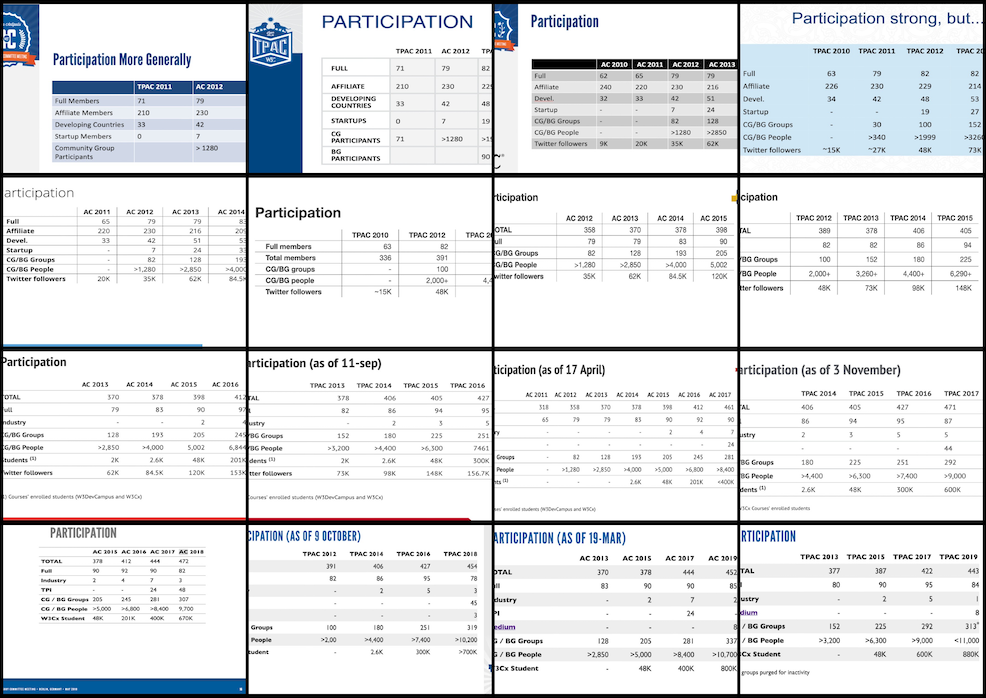
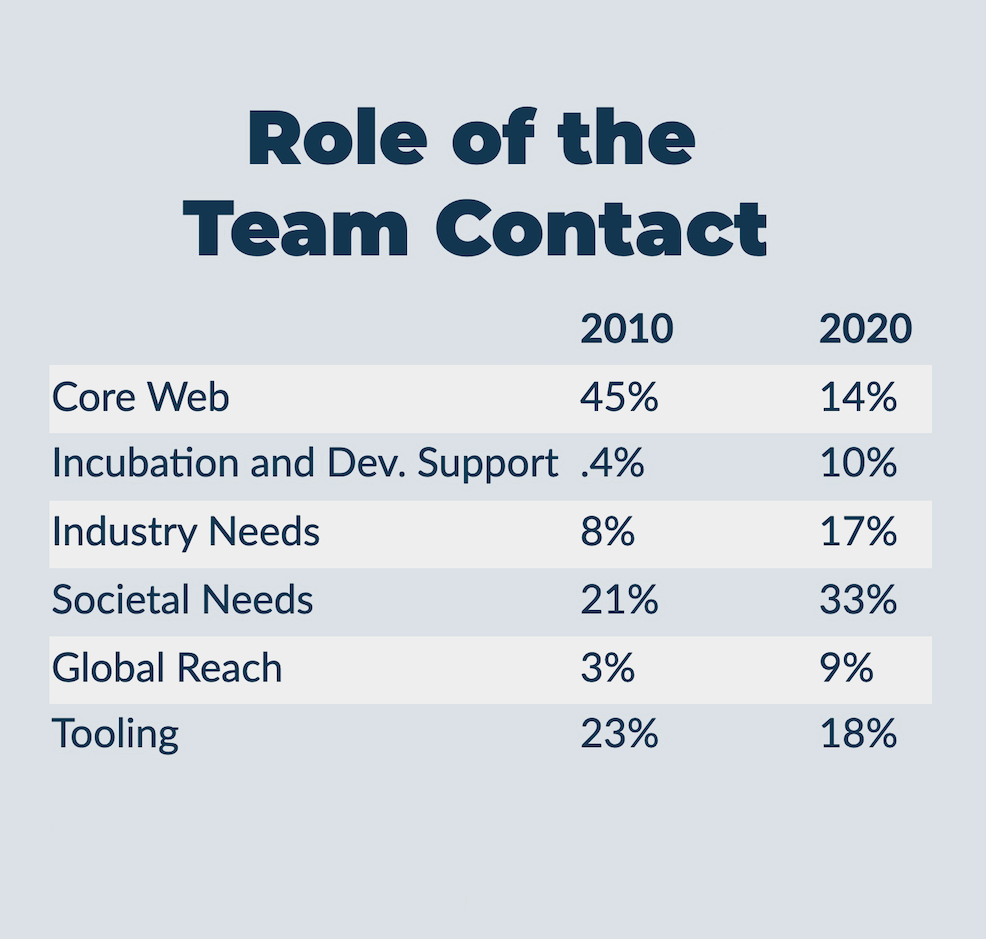

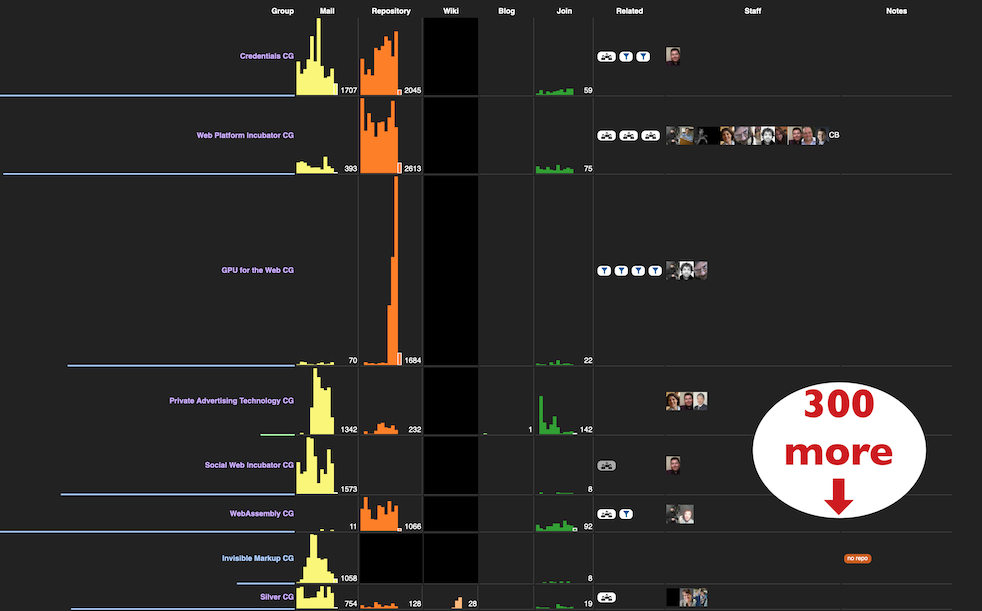

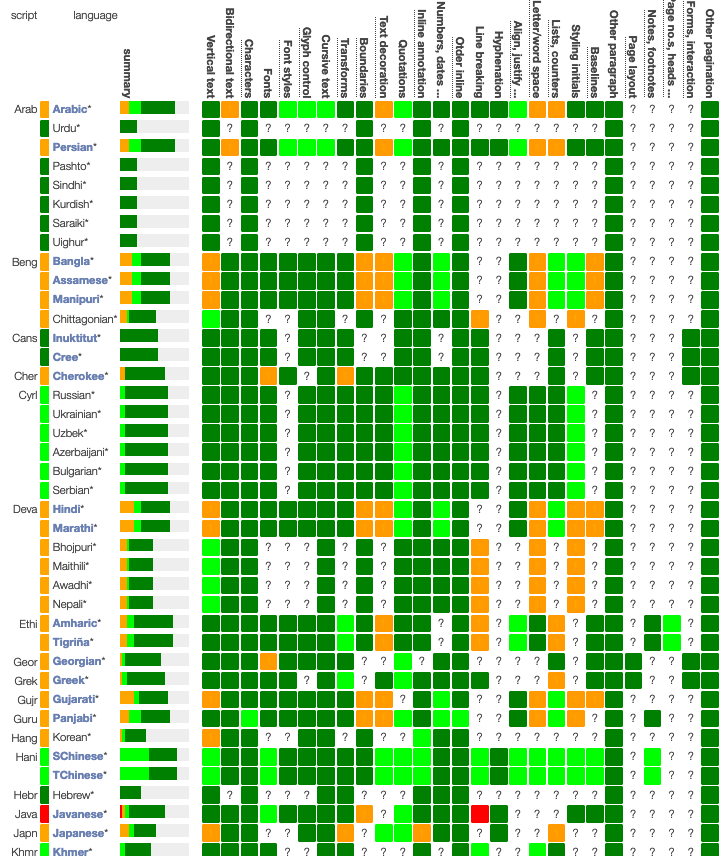

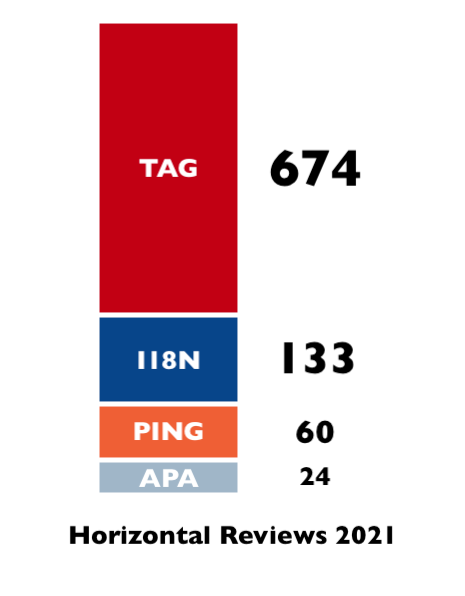
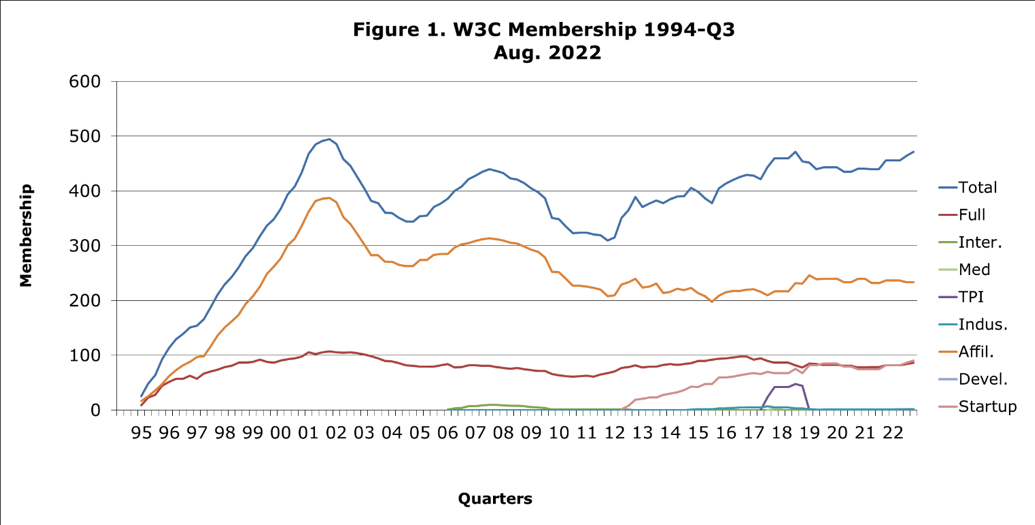
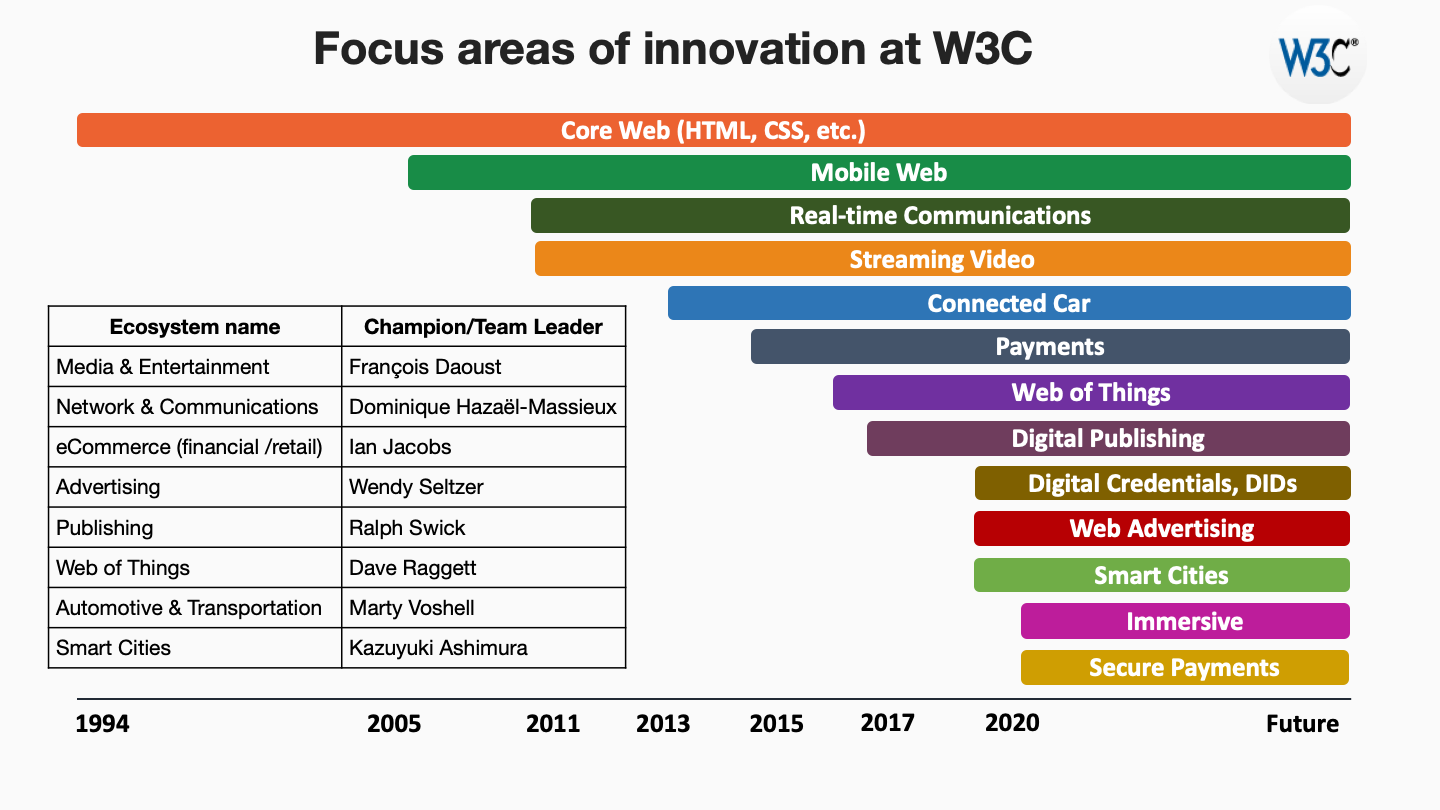
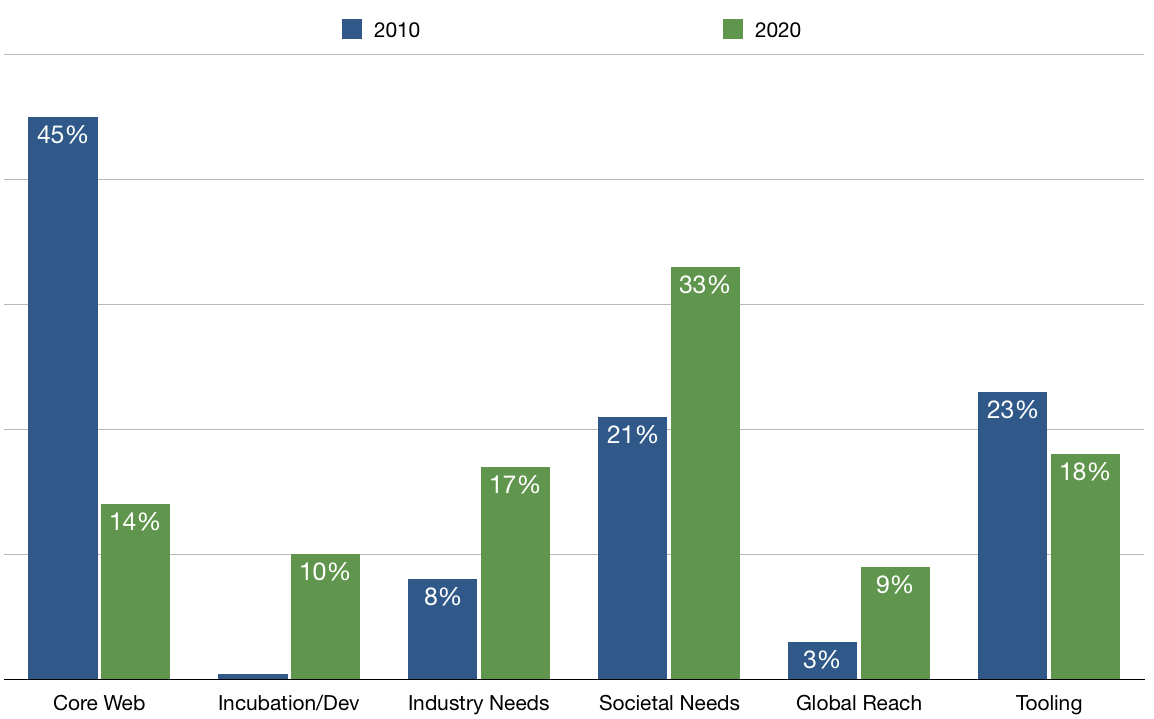
Skip ⬇
Comments & questions
If you have questions about this talk, you can help by submitting them in advance of the live session on 13 September. (Of course, you can also ask questions during the sessions.)
Comment by ? on ?:
Note: Comments are visible for anybody with member access.